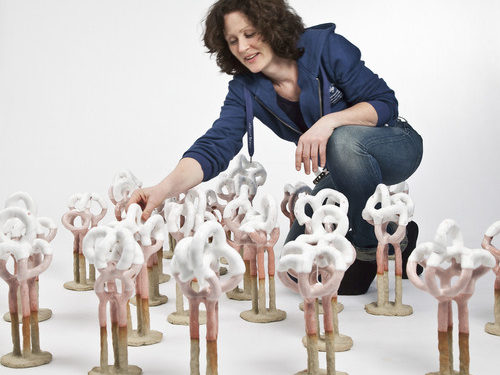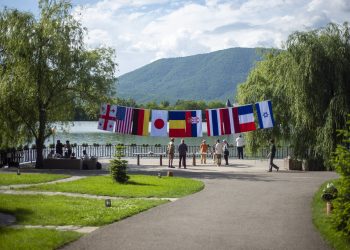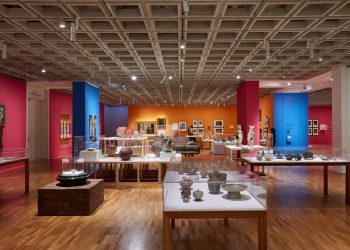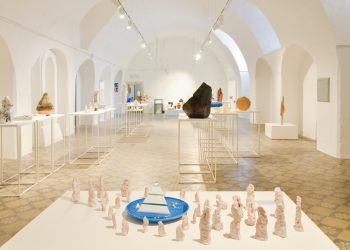
As a Danish ceramic artist, do you consider the living climate an important influence in your work?
I think it’s fair to say that my works have a certain Nordic nature component. Danish nature is not wild and magnificent – more one that offers quiet experiences: a misty morning over the ploughed fields; an old, dead tree; rainy weather that starts as dark streaks on the horizon; the weather clearing up after rain. Danish weather is changeable and often a cold, clammy affair, but this makes one more keenly aware of the light and small shifts in nuance.
Your work have been described as highly experimental. From the slip-cast rigorous design to the hand-built structures, you have been experimenting different body of works over the years. How do you find yourself shifting subjects and manners? Is it a continuous change?
I have never personally felt that I undertook dramatic shifts. I see my work as an on-going development, where one thing leads to the next. I will never completely finish – fortunately. While working, new ideas emerge that have to be tested. One could say that the experiments themselves ask the next questions. Ceramics has so many possibilities, and I like challenging the material and myself.
What influences and inspires you the most in your creation? How would you describe your current body of work?
With my background as a ceramist I nearly always have my point of departure in an idea to do with material or form. This can, for example, be new form expressions achieved by special compositions, or through cuts or glazing experiments that result in strange surfaces and textures. I often gain inspiration from nature’s formal principles and phenomena. Work takes place systematically and always on the premises of the ceramic material, but the investigations often develop into something that is reminiscent of large, amorphous nature-abstractions, with plenty of glaze. The fantastic thing about clay is that what is nature’s own material can constantly be transformed into something new and relevant.
Delicacy and sensitivity are two powerful characteristics of your work. How much do you rely on intuition and how much on unpredictability?
I make use of both in my work. Ceramics has an innate unpredictability, especially because it is out of one’s hands during the firing at high temperatures. This unpredictability is a challenging co-partner and opponent. All the time, one gets something more or less intentional for free, and from there one has to decide if and how it can be used. My intuition has probably been honed by many years’ experience of this process.
Besides a very playful approach in manipulating clay, you ingeniously use colors and assets of glazes in your work. Tell us more about the importance of color and its use in your creations.
Previously, I was mainly interested in the ability of glazes to interact and behave differently, according to the thicknesses involved. At my ‘Interglacial Period’ exhibition in Galleri Nørby in 2005, it was mainly green/turquoise, because copper is very good at producing that sort of thing. Then came the exhibition ‘Elements in White’ at Galerie Maria Lund in Paris in 2008, where I almost washed the slate clean and experimented with various textures within white glaze.It was not until the more recent works ‘Clouds’ that I seriously explored selecting more precise colours. Here I have thought more in psychedelic colours, the colours of the sky, sunrise, violet, pink and yellow. It has been interesting to include these more ‘un-ceramic’ colours.

Bente Skjøttgaard: Purple white cloud no 1002, 2010, Stoneware and glaze, hand built, 37 x 55 x 27 cm. Photo: Ole Akhøj
You are one of the initiators and directors of the Copenhagen Ceramics platform. How did this project start? Tell us more about the objectives of this new Danish movement.
The project Copenhagen Ceramics has been implemented by the ceramic artists Steen Ipsen, Bente Skjøttgaard and Martin Bodilsen Kaldahl, based on having noted that there was no longer any exhibition venue in Copenhagen where the best of the great diversity of ceramic expression existing in Denmark could be shown and experienced ‘live’. Another important aspect of the project is the Internet platform www.copenhagenceramics.com, which we wish to use to disseminate knowledge of Danish ceramics internationally.We have planned the 10 exhibitions for 2012: 4 solo exhibitions, 5 two-man exhibitions and a single group exhibition with six of the best ceramic artists from the younger generation. The individual artists have been selected and linked together in new constellations that enable completely new artistic facets in all of them to emerge – also among those already more established.
What has been the biggest challenge of starting Copenhagen Ceramics?
The greatest challenge was time and money! All three of us are practising ceramic artists in full mid-career, so it was also with a certain amount of hesitation that we threw ourselves into yet another ambitious project. For the time being, we have also only planned one year with Copenhagen Ceramics. That is what we feel we can keep tabs on. And when people ask us: What about next year? We answer: We don’t know! Financially speaking, we have been fortunate enough to have gained initial funding from Danish Crafts and later also from OAK Foundation Denmark, Ellen og Knud Dalhoff Larsens Fond and Danmarks Nationalbanks Jubilæumsfond af 1968.
One of the events organized by CC was a co-exhibition entitled “Cuts and Interventions”, where you exhibited together with Bodil Manz. How would you describe the exhibition, and your collaboration with Bodil?
At first glance, Bodil Manz and I might seem to be diametrically opposed – Bodil’s sophisticated, wafer-thin porcelain works against my rough-hewn, expressive experiments with glaze. But there are also common denominators. The title of the exhibition, ‘Cuts and Interventions’ points towards the way in which we both control materials and the working process.

Bente Skjøttgaard: Frieze P7 no 1209, 1207 and 1210, 2012, Stoneware and glaze, 180 x 45 x 7 cm. Photo: Jeppe Gudmundsen-Holmgreen
What are you currently experimenting in terms of new ceramic approaches and what are your plans for the future?
At the exhibition ‘Cuts and Interventions’ in Copenhagen Ceramics I displayed my latest project: Frise P7.
The frieze is a classic within ceramic decoration that I first felt like referring to in this project, where we are talking about friezes with relief patterns from car tyres – Pirelli P7 tyres, to be precise. Using these, I have explored the possibilities of creating a modern frieze ornamentation.
Stoneware clay with chamotte and fibre are thrown down to form a long track. After that, a car drives slowly through the clay in a single track. A direct imprint. Glazed and fired at 1,280°C. The project was realised at Tommerup Keramiske Værksted on the island of Funen.
Frise P7 is a perpetuated imprint in fired clay of our own Fiat Multipla, and at the same time a very recognisable trace of our own age. The P7 tyre pattern forms a beautiful relief in the clay. The length of the relief is important, bearing in mind that it is to be a frieze, but also because we are dealing with a track, a trace. The relief pattern forms a basis for the ceramic glazes. They can run down into cracks and pull away from edges and thereby accentuate the pattern. In other, the track can be partially camouflaged by a thick layer of glaze. It depends completely on the nature of the glaze to what extent the tracks become prominent. Some more directly than others. Others perhaps more like a pattern that an actual car track. What also interests me is the clash between this mechanical, industrial imprint and the clay. Apart from the ability of clay to perpetuate the imprint, it is a soft, sensual and tactile material. One can also speak of an intervention when the clay is exposed to being directly driven over by a car. Despite this, the friezes are not only violent and expressive but also provide food for quiet contemplation.
The Frise P7 project is of course a continuation of my contribution to the Danish Arts Foundation project ‘Art along Hærvejen’ in 2010, where I let cows of the ‘Jutland cattle’ breed, which used to be driven along the ancient road Hærvejen in the old days, leave imprints of their cloven feet in an approx. 40 sqm red-clay relief, which has now been put down at the Hærvejen nature trail, close to the village of Bække in Central Jutland. And behind this, there is of course a greeting being sent to Asger Jorn’s large-scale ceramics relief from 1959 at Århus Statsgymnasium upper secondary school, where Jorn, as is well known, rode his scooter through the clay while making the work.
Interview by Andra Baban, published in Ceramics Now Magazine, Issue 2.
Visit Bente Skjøttgaard’s website.
View the list of interviews with ceramic artists.



















